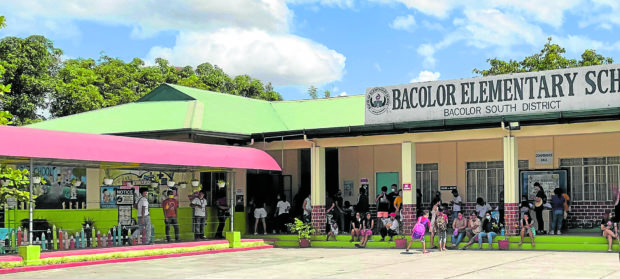Polls rouse Pampanga town buried by lahar

CIVIC DUTY | Residents of Bacolor, Pampanga, dispersed by Mt. Pinatubo’s eruption and lahar flow 30 years ago, return to their town to fulfill their civic duty and vote. (Photo by TONETTE OREJAS / Inquirer Central Luzon)
BACOLOR, Pampanga, Philippines — Thousands of residents scattered in 10 government-built resettlement sites in Pampanga province returned to this town on Monday to exercise their right to vote or to renew ties to their community.
A year before Bacolor was buried by lahar (volcanic mudflow) following the eruption of Mt. Pinatubo on June 15, 1991, the town had a population of 67,228 based on a census done in May 1990. The population drastically dropped to 13,097 by 1995 and gradually grew until it reached its current population of 48,066, based on the 2020 census.
In fact, the town currently has more chickens, particularly in the village of Concepcion where some 100 poultry-raising residents tend to around 50,000 layer chickens.
But Bacolor has a higher number of voting population than its actual number of residents. It has 49,843 registered voters in 21 barangays for this year’s elections. However, many of them who have resettled elsewhere would only come home to cast votes during elections.
One of them was villager Rogelio Calilung, who availed of a free ride for the around 12-kilometer distance from the Bulaon resettlement in the City of San Fernando, the provincial capital, to be able to vote at Bacolor Elementary School.
“Elections are the only time I come back to my old hometown,” Calilung, a 62-year-old electrician, told the Inquirer.
He and his family relocated to the Bulaon resettlement site after 20-meter high lahar that overflowed from the Pasig-Potrero River at the height of Typhoon “Mameng” (Sibyl) on Oct. 1, 1995, buried his home.
“I want to come back to my original village of Cabambangan because it is noisy in Bulaon,” he added.
The likes of Aurora Pamandanan and Lourdes de la Cruz, both of Barangay Talba, also come home from Madapdap resettlement in Mabalacat City during the feasts of the dead (All Souls’ Day and All Saints’ Day), of their the patron St. William the Hermit (San Guillermo) and of Our Lady of La Naval.
In Pamandanan’s case, she could not come home because the landholdings in her village were now grown with sugarcane. In De la Cruz’s case, she could not afford to build a house where her home once stood.
RELATED STORY
Tour brings back Bacolor past buried by Pinatubo eruptions, lahar